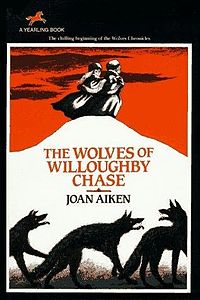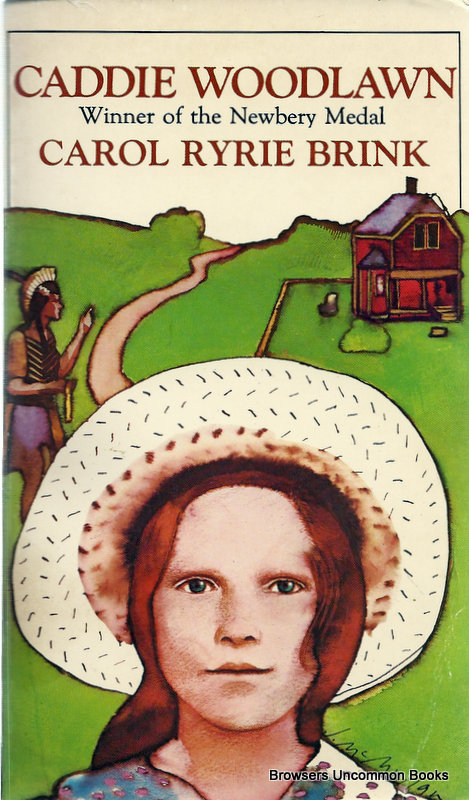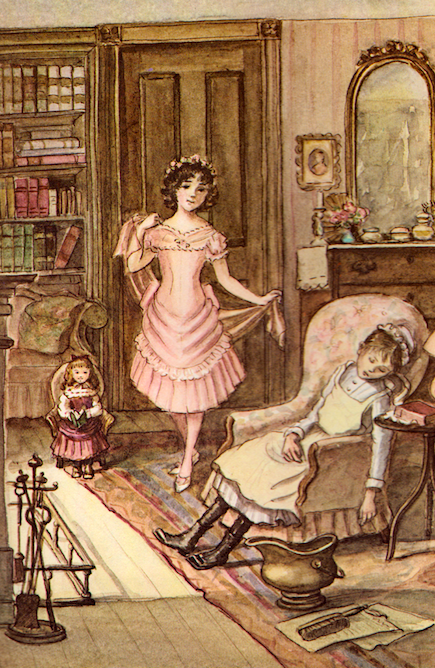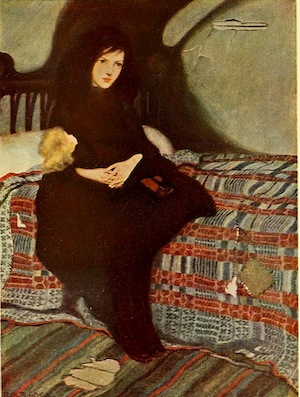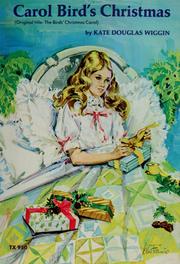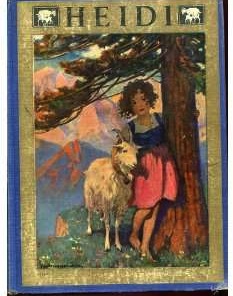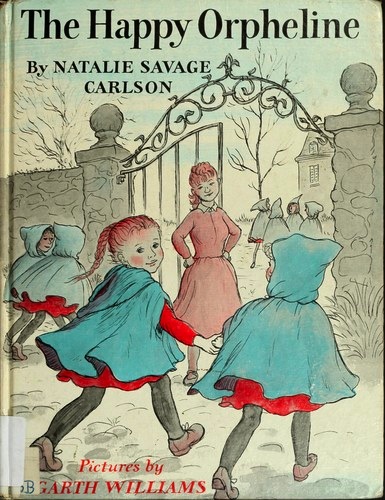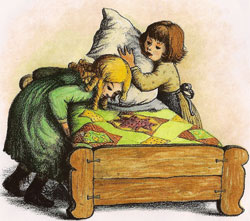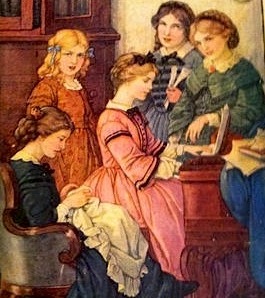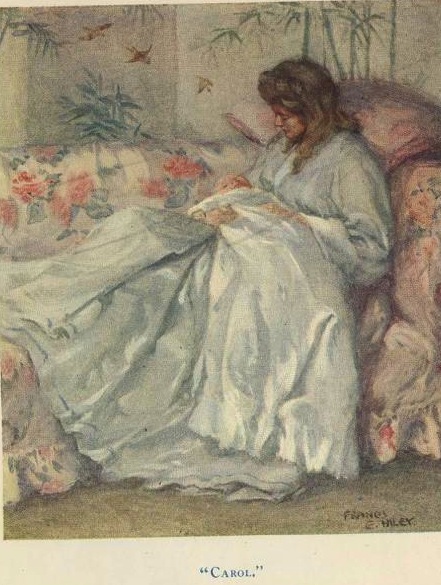
Carol Bird, the dying Christmas Swan
I really became a bookworm around the age of 8, and the books I read then lodged themselves in my brain forever. Primarily because I read them over and over and over again. Between the ages of around 8 and 10, I probably re-read the entire 9-book set of Little House on the Prairie books and the entire Trixie Belden canon of mysteries 10 times. I think it was seen as a sign of my budding eccentricity. I used to take to my room and read – with a bowl of candy ala Francie Nolan – these books in a vaguely seasonal rotation, over and over, in their entirety, like some pre-teen addict. I think it felt as if there were a finite number of books for me, and after exhausting everything in our small local library and ever smaller school library, I really had basically read everything there was to read. I would beg my mother to take us to the BIG LIBRARY – a marginally less small library than the one in our neighborhood. I read quickly and obsessively and it didn’t stop until I matured into the next level, and more vast of reading material. The supercharged imagery in the 8-year old books are seared in my brain forever.
It’s generally good policy to avoid revisiting the books we coveted as children. There’s nothing wrong with feeling deep nostalgia for those delightful tomes, as long as we know that what we are looking for from them is not exactly as we remember. Folks who grew up in the 1950s may wax nostalgic about hula hoops and Elvis Presley, leaving out the part about McCarthyism and women’s roles vacuuming for Jesus and popping out quiverfulls of babies like Michelle Duggar. I had an exceedingly privileged childhood. Good schools, plenty of food, summer camp.. But I often lived more through my books then through my own experiences, and literally (not literally), every heroine in every book I read had a life more desirable than my own.
The Wolves of Willoughby Chase
Little Sylvia is dirt poor, an orphan living with a decrepit old aunt. When her aunt gets too old to care for her, she is shipped off to live with her rich cousin Bonnie at Willoughby Chase.
During her train trip, she is attacked by starving packs of wolves who leap through the windows of the train.
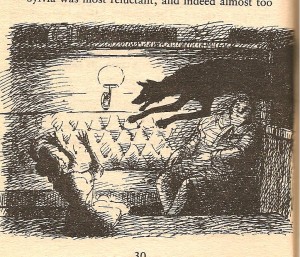
Sylvia’s malevolent seat-mate grabs a shard of glass and stabs a wolf in the throat and then heaves its carcass out the window. In fact, the entire landscape is literally crawling with salivating wolves, made savage and reckless from hunger.
Once at Willoughby Hall, Sylvia and her Bonnie are immediately deserted into the care of a cruel governess named Miss Slighcarp who locks them in the attic and abuses them, before sending them to a prison-like orphan school for endless hours of drudgery and horror, subsisting on dry bread morsels and water. But, there is Simon the cute gooseboy who lives in an underground cave in the forest with his geese and a little donkey…once an exhausted and feverish Sylvia is tucked into Simon’s donkey cart with feather-filled mattress and quilts below and warm feathery geese on top. Lulled by the soft warmth, she slumbers. The book is crammed with other such sumptuous descriptions – of ice-skating in the frozen park cosy, fire-lit nurseries and violet cream pastries – that had me longing to be in Sylvia’s old shoes.
Caddie Woodlawn
“In 1864, Caddie Woodlawn was 11 and as wild a little tomboy that has ever ran the woods of Western Wisconsin”.
Caddie Woodlawn was a weak and sickly child, on the verge of death, during the Woodlawn family’s treacherous journey from Boston to Wisconsin. Her younger sister Mary, had already gotten sick and died en route. Fearing for Caddie’s life, her father allows her to “run wild” with her brothers to regain her health.
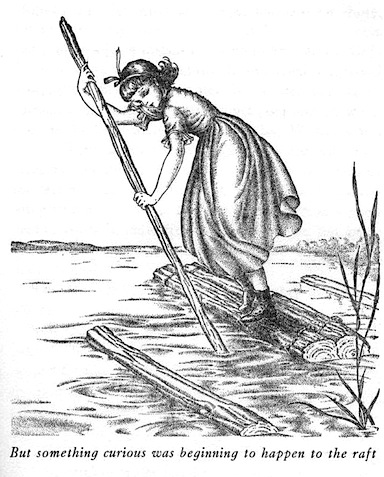
God I envied her, being set free like an animal to run wild in the woods that were lousy with dangerous Natives and man-eating animals. She falls through a lake while ice skating, and worse yet, is condescended to by her snooty Cousin Annabelle from Boston, “who arrives on the Little Steamer finely dressed”. I suddenly needed to be a red-haired hellion left to her own devices in the woods.
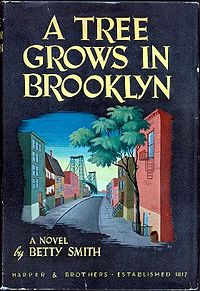 A Tree Grows in Brooklyn
A Tree Grows in Brooklyn
YES, I did. I DID want to be a dirt poor Irish Catholic girl in a Brooklyn tenement. I DID want to be 11-year old Francie Nolan, in smelly rags, living in (pre-hipster) Williamsburg, Brooklyn – when it was still a bastion of filth and scoundrels. I admired Francie’s pluck and imagination and her love of reading, working her way down the school library shelves from A to Z. Sure, Francie’s mom is a janitor, and her dad is a singing waiter crippled by alcoholism. But, there is no dissension in the Nolan household, everyone likes each other. Sure, Francie is spat upon, ridiculed, molested, derided as a “rag picker” and betrayed. But, when she has a nickel she can go to “Cheap Charlie’s and buy herself pink and white peppermint wafers. Francie’s family goes on picnics and boat rides thrown by Tammany Hall. Like me, Francie loves candy (‘The world was hers for the reading, with a fine book and a little bowl of candy, and all alone in the house”). And best of all, she has Aunt Sissy, who is brassy, promiscuous and devoted to Francie, wears a cherry- colored bow in her hair, works at a rubber factory and buys Francie chocolate sodas.
Francie is face to face with the horrific realities of her life: death, hunger, pure human hatred, and brutality. Her world is sordid and sumptuous at the same time. Amidst the terrible misery, squalor, degradation and grinding poverty of their lives, Brooklyn is still like a dream world, and I would have traded places with her in a minute.
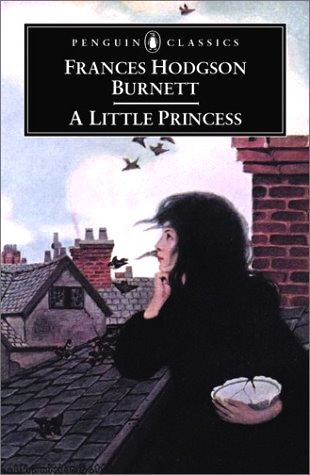 A Little Princess
A Little Princess
A preternaturally pampered young girl brought up in Colonial India, the highly adored daughter of a young, wealthy officer, is brought to London to attend a fancy girls’ school, run by the odiously named Miss Minchin.
This book is the gold standard of non-sexual pornographic descriptives. There’s the food…..sugar buns and little meat pies, and hampers full of jam tarts and frosted cakes, red-currant wine, figs and chocolates. And the clothes….Sara is distinguished from the other rich students by trouncing whatever finery they have with her epic wardrobe: fur-trimmed velvet dresses, lace dresses, and embroidered ones, hats with great, soft ostrich feathers, and ermine coats and muffs, and boxes of tiny gloves and handkerchiefs and silk stockings, and exquisite “underclothing” with real Valenciennes lace. Sara’s DOLL, in turn, is taken to a children’s outfitter’s shop and measured for a wardrobe as grand as her own, including a jewel-case containing a diamond tiara, a long sealskin and muff, ball dresses, tea-gowns and fans. At school, Sara is given her own pony and cart, and a French maid named Mariette.
The most coveted of Sara’s outfits is a diaphanous, rose-colored dancing frock with which she wears a wreath made of real buds on her black lock. But what I envied most of Sara Crewe’s was her private “suite” of rooms, a bower of luxury that includes its own fireplace, a tiger skin rug with a cat head and a cupboard for cakes. She has a cake cupboard in her room.
When Sara is told – in the midst of her chimerically lavish 11th birthday party – that not only is her father dead of jungle brain fever, but that his entire fortune is gone, she is tossed out of her parlor suite, stripped of her party frock, and shut up in a freezing, rat infested attic.
The dingy room has a hard, cold bare floor, an hard iron bed covered with a thin, faded coverlet and a broken stool. It has a romantic slanting roof, like a garrett! She befriends the rats! It is….cozy!
To an 8-year old who hadn’t yet gotten her first dose of Dickens, this whole being poor orphan in Victorian England things didn’t seem half bad! Somehow, the attic was just as desirable as her luxurious parlor rooms.
I loved how this book evoked all the senses of poverty. When Sara wakes up to find her crummy attic transformed into a cozy, comfortable little living space, complete with a crackling little fire and biscuits and soft Indian slippers… Sigh. I think I found nothing as exciting as a poor mistreated orphan…. swoon!
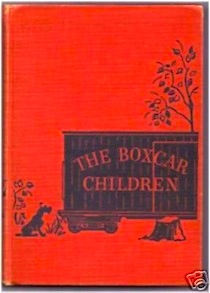 The Boxcar Children
The Boxcar Children
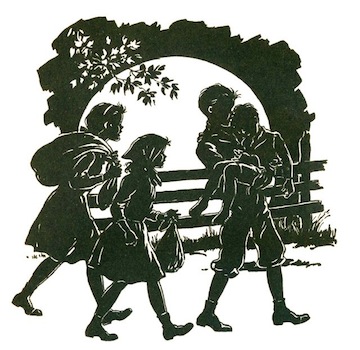
Four orphaned siblings roughin’ it! Henry, Jessie, Violet and little Benny buy bundles of bread and sleep in a bakery shop until they spy a cute old boxcar standing idle in the woods, next to a creek for water and a trash dump for Deux Ex Machina! “Oh, please Henry, we could have the nicest little home!” the little ones plead. Henry goes into town to work “odd jobs”, while the younger children scavenge the dump to find what they need to set up home in the boxcar! With a little”Gilligan’s Island”- style ingenuity, the moppets make a cozy new home. They make a bed from pine needles and a ladle from a cup, a stick and some wire. They bathe in the brook, gorge on blueberries and milk, they frolic in a cherry orchard, they even dig themselves a swimming hole and find a great dog.
What gal doesn’t dream of having her own space, sans parents, creating her own version of reality? The idea of kids surviving all alone, setting up house in a delightful abandoned boxcar, feasting on cherries, made me yearn to be rid of the shackles of suburban entitlement in favor of living in a goddamn boxcar.
A Bird’s Christmas Carol
Carol Bird is as beautiful as Nellie Olsen and as sweet and selfless as Tiny Tim. Born on Christmas Day, tiny, sickly Carol is the Bird family’s beauteous Christmas baby. Her cheeks and lips were “as red as holly berries; her hair the color of a Christmas candle-flame; her eyes bright as stars; her laugh like a chime of Christmas bells”. Alas, as her tenth birthday approaches, Carol is in such bad health that she is bed-bound. Sweet Carol’s only dying wish is to hold an unforgettable Christmas celebration for the poor children next door, the grubby “Ruggles kids.”
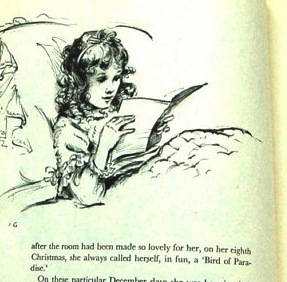
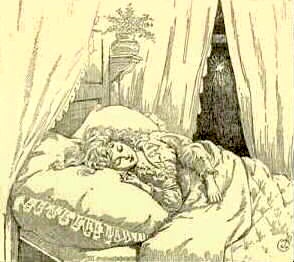 I envied Carol first for her beauty, second for how she’s adored by everybody, and lastly for her terminal illness which allows her to remain in bed. Carol’s adoring Papa builds her a dream room overlooking the garden,filled with windows overlooking the little Church of our Saviour. Everything in decorated in Christmas theme: the carpet has clusters of holly leaves, the furniture is painted snow scenes and Christmas trees and merry children singing carols. Love-birds and canaries hang in their “golden houses” in the windows, and there’s a bookcase filled with- literally – hundreds of books. Carol also has hundreds of outfits in her closets – alas, all nightclothes and dressing gowns – because for some reason Carol can’t even get dressed in regular clothes.
I envied Carol first for her beauty, second for how she’s adored by everybody, and lastly for her terminal illness which allows her to remain in bed. Carol’s adoring Papa builds her a dream room overlooking the garden,filled with windows overlooking the little Church of our Saviour. Everything in decorated in Christmas theme: the carpet has clusters of holly leaves, the furniture is painted snow scenes and Christmas trees and merry children singing carols. Love-birds and canaries hang in their “golden houses” in the windows, and there’s a bookcase filled with- literally – hundreds of books. Carol also has hundreds of outfits in her closets – alas, all nightclothes and dressing gowns – because for some reason Carol can’t even get dressed in regular clothes.
Even though she was totally dying, I longed to be Carol Bird, with her cascading golden curls and her silk dressing gowns, planning holiday parties from her deathbed. She was beautiful, pampered, adored for being angelic, and gets to die a martyr. What more could a miserable, snaggle-toothed, 9-year old reader.
Heidi
NO not happy-go-lucky HEIDI, I wanted to be Clara paralyzed one.
Clara Sesseman is the daughter of a rich family, they live in Frankfurt, Clara’s mother is dead and she is confined to a wheelchair, but her father dotes on her, instructing her harsh governess Mrs. Rottenmeier, that she should have say in everything, and that everything ought to be done according to Clara’s every wish.
Clara has a”small pale face with two mild blue eyes”. I had several editions of Heidi and the illustrations uniformly had her beautiful, tall and slender with long, white blond hair. Because she is rich, she wears beautiful dresses and lives in a beautiful rich persons house, whereas poor Heidi has to live in a crappy hovel in the mountains.
Also, whereas Heidi has to hike up mountains to the point of exhaustion, in the hot sun, Clara gets to laze around in a “comfortable rolling chair”, rolling from one room to another, making demands of old Mrs. Rottenmeier. What a life!!!
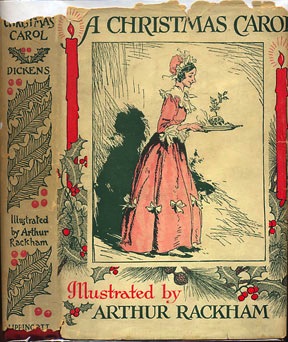 A Christmas Carol
A Christmas Carol
ls it any wonder susceptible children think it’s better to be poor, with stories like this? Scrooge, rich and miserable in a dirty, cold house where ghosts go flying by. The poor Cratchits, snug as bugs in their cozy, tidy hovel with fires burning.
The poor part of town was much, much better than the rich parts; everyone is cheerful and the streets are full of shops teeming with “great, round, pot-bellied baskets of chestnuts, shaped like the waistcoats of jolly old gentlemen, lolling at the doors, and tumbling out into the street in their apoplectic opulence” (nobody does food porn like Dickens). There are blooming pyramids of pears and apples, “French plums blushing in modest tartness from their highly-decorated boxes”, and “candied fruits so caked and spotted with molten sugar as to make the coldest lookers-on feel faint”
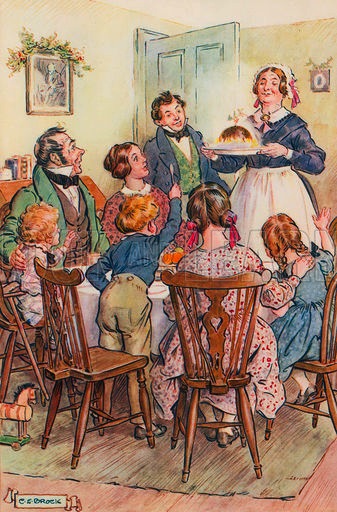
At every step, you are informed that the poor folks have it better than the rich (it’s a fantasy after all).
Then there’s the familial coziness of it all, the way the poor Cratchits make merry out of shit. They make the most of their scraggly strangled goose, the jug of weak grog made from apples and oranges, a shovel full of chestnuts on the fire, the family draws round the hearth.
“They were not a handsome family; they were not well dressed; their shoes were far from being waterproof; their clothes were scanty; and Peter might have known, and very likely did, the inside of a pawn-broker’s. But they were happy, grateful, pleased with one another, and contented with the time….”
The dishes were always cleared, the hearth swept, and the fire made up. The children looked rich enough to me – they had everything that mattered: ringlets, dresses and velvet suits. The little girls, and this is embedded in my head forever, were shabby, but “brave in ribbons”. And I was, of course, most envious of Tiny Tim, despite of or maybe because – he was ” lame”, and rode on his father’s back like a “blood horse”, never had to walk! And everyone adored and fawned over him.
And then there is The Pudding, Mrs Cratchit’s pudding, “like a speckled cannon-ball, so hard and firm, blazing in half of half-a-quartern of ignited brandy, and bedight with Christmas holly stuck into the top.” And these are the poor folks foods!
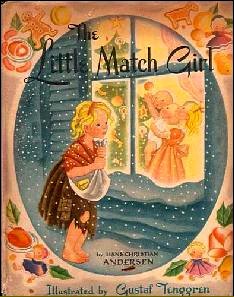 The Little Match Girl
The Little Match Girl
As the jovial holiday bustle rushes by her; the little match girl is terrified to go home, because her father will beat her.
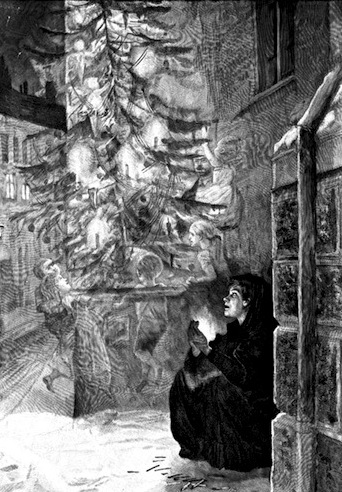
So, shivering with cold and hunger, bare feet literally blue with cold, the little match girl suffers in the cold, the very picture of misery. Starving and freezing to death, she lights a match and imagines a room with a shining dinner service, a gloriously smoked roast goose stuffed with apples and dried plums, a beautiful Christmas tree with thousands of candles and colored pictures like those in the print shops. I envied her hallucinations, coveting those food images.
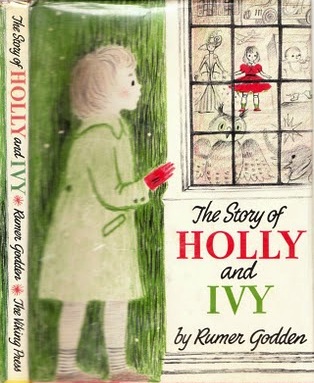
The Story of Holly and Ivy
6-year old Ivy is the only child left at the orphanage at Christmas. She has straight hair cut in a fringe, blue-grey eyes, and a turned-up nose. She has a green coat and red gloves. Ivy is packed off to spend a cheerless Christmas at the “Infants’ Home” in the country. She is put on a train with a sandwich and a parcel that was her Christmas present – a pencil-case – not the longed-for doll. Ivy decides to take off in search of a non-existent grandmother.
Meanwhile, there is a doll named Holly in Mr. Blossom’s toyshop, dressed for Christmas in a scarlet party dress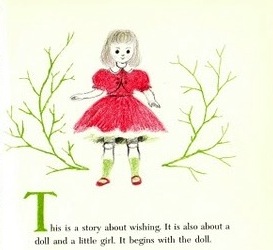 , green petticoat and socks and red shoes. She has “real gold hair, brown glass eyes, and teeth like tiny china pearls”. As Ivy trudges through the snow, about to face the fate of the aforementioned little match girl, she spies Holly through the shop window.
, green petticoat and socks and red shoes. She has “real gold hair, brown glass eyes, and teeth like tiny china pearls”. As Ivy trudges through the snow, about to face the fate of the aforementioned little match girl, she spies Holly through the shop window.
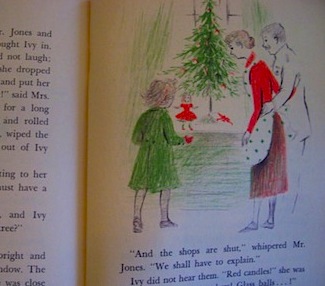 Meanwhile, a policeman and his wife, Mr and Mrs Jones – middle-aged and childeless – long for a little girl. The Jones’ tree beams from their front window, magnetically drawing Ivy in. Officer Jones is walking the beat when he discovers the cold and disheveled girl, dusted with flour from sleeping against the back wall of a bakery, and takes her home. Yes, I wanted to be little orphan Ivy, with her Christmas colored clothes, her turned up nose, that magnificent doll, even her goddamn pencil case.
Meanwhile, a policeman and his wife, Mr and Mrs Jones – middle-aged and childeless – long for a little girl. The Jones’ tree beams from their front window, magnetically drawing Ivy in. Officer Jones is walking the beat when he discovers the cold and disheveled girl, dusted with flour from sleeping against the back wall of a bakery, and takes her home. Yes, I wanted to be little orphan Ivy, with her Christmas colored clothes, her turned up nose, that magnificent doll, even her goddamn pencil case.
 The All of A Kind Family
The All of A Kind Family
Ever fantasized about being part of a poor immigrant family living in New York’s Lower East Side on the eve of World War I? Sure they’re poor, but the lives of the five pretty sisters girls are rich with candy, library books, ecru lace dresses and buttonhooks! Even the vision of household labor is so deliriously fetishized (“I want a little washboard and a little tub so I can wash my dolly’s clothes” says the littlest sister Gertie), that I longed to scrub and mop.
Ella, Henny, Sarah, Charlotte, and Gertie are turned out in matching dark woolen dresses, crispy white aprons, petticoats and long woolen stockings. Their hair is neatly plaited or smoothed back by bows and bands. My hair stood up and I dressed in grubby, high water Danskins. My 9-year old mind asked: was poor better?
Wearing 8 petticoats on the beach,  getting lost on Coney Island only to be helped out by a kindly Irish policeman who buys them a peanut-candy bar….sure there were the scary, crowded streets, creepy peddlers, scarlet fever and abject poverty, but they are so cozy in their tenement apartment. So cozy. What little girl doesn’t respond to that sense of coziness? Their cozy safe space has its special, beautiful little objets The girls are happy! Happy with simple, old-fashioned talk, make-believe, chocolate babies, pickles, and broken crackers from a giant barrel. Papa is a literal ragman, with hands so cracked and dirty that the “dust seeped in beneath the skin no matter how much he cleans them.” How does stamping rags and old books and bums seem cozy? It fucking does.
getting lost on Coney Island only to be helped out by a kindly Irish policeman who buys them a peanut-candy bar….sure there were the scary, crowded streets, creepy peddlers, scarlet fever and abject poverty, but they are so cozy in their tenement apartment. So cozy. What little girl doesn’t respond to that sense of coziness? Their cozy safe space has its special, beautiful little objets The girls are happy! Happy with simple, old-fashioned talk, make-believe, chocolate babies, pickles, and broken crackers from a giant barrel. Papa is a literal ragman, with hands so cracked and dirty that the “dust seeped in beneath the skin no matter how much he cleans them.” How does stamping rags and old books and bums seem cozy? It fucking does.
The Happy Orpheline
“Not long ago there was a little girl who lived in a village near Paris. Her first name was Brigitte and her last name didn’t after because she lived in an orphanage”.
And there you have it. 20 happy little orphelines. And Brigitte was the happiest of them all. The orphelines are very, very happy together; so much so, that being adopted is the worst possible fate.
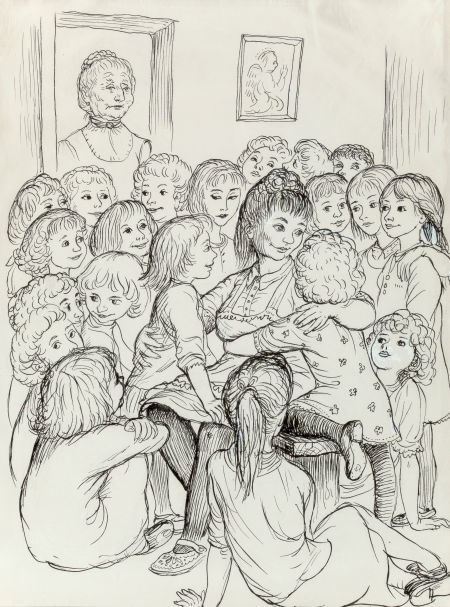
The happy orphelines are tended to by the deliriously loving Madame Flattot and Genevieve and are so happy and cozy. On an outing to the dog cemetery, Brigitte is separated from the other orphelines. She must make her way home with the help of a fancy lady named Madame Capet. Madame Capet falls for Brigitte and announces her intentions of adopting her! But wait! Brigitte does not WANT to be adopted! She is too happy at the orphanage! Brigitte has to do something really wicked so that Madame Capet won’t want her! At the end of the day, Madame Capet just gets a dog or maybe it was a bird, in any case, this book convinced me that it was preferable to live in an orphanage than to be with a family.
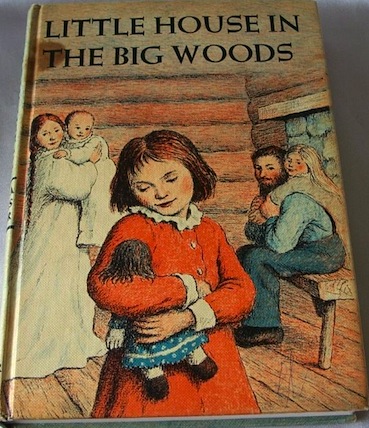 Little House in the Big Woods
Little House in the Big Woods
There’s something to be said for a book series that makes you long to have been part of a dirt-poor pioneer family, struggling to survive, subsisting on potatoes and old stale bread. No one did Poor-Envy better than The Little House books. Even though they were poor as shit, the Ingalls Family still seemed exponentially more desirable than my own, for the following reasons: frontier food, clothes and all the domestic details of the Ingalls family i.e. “frontier porn”. Molasses candy, cooled in a pot of snow and buckets heaping full of dripping, golden honeycomb, a candy heart wrapped in a handkerchief, that Pa makes the girls a doll’s tea set made from leaves, and Ma curls their hair with rags and sews them matching calico dresses (Laura’s: dark red, Mary’s: “china-blue”, complimenting their coloring).
The book is a wholly sensual experience for the underaged set. Laura is round and strong as a little french horse, Aunt Ruby’s fine dress was the color of wine and Aunt Docia’s dress was a sprigged print basque, dark blue, with sprigs of red flowers. Ma’s delaine dress was dark green, with a little pattern that looked like ripe strawberries, with a ruffled and flounced skirt trimmed with knots of dark green ribbon. Perfect Mary was sitting primly, with her golden curls shining and her china-blue dress fresh and crisp. I learned that even during the 1860s, brown-haired girls felt inferior to their blonde sisters.
Everything in the Ingalls’ humble home was neat, orderly and simple. Sure there are swarms of bees and locusts, scarlet fever, blindness, “fever ‘n’ ague”, blizzards howling down on their poorly insulated claim shanty, always without any heads-up from God…..but it’s never chaotic. My home was always in chaos, even though we were not struggling to eat, to save our crops, or to keep our shanty from blowing away. I yearned for that peaceful, simple life, to have that quiet family bond, to cherish one, humble, beautiful object. Laura and Mary’s Christmas stockings have a single – ONE – candy stick and – yowza! – an orange. Yet, those spartan pioneer stockings seemed more desirable than my own, over-stuffed with expensive marzipan. My own pile of presents from FAO Schwarz paled next to Laura’s pair of scratchy bright red mittens. I coveted her crappy doll, literally made from rags, even though I had half a dozen 14″ Madame Alexanders. Maybe because Laura’s doll’s cheeks and mouth were red with the ink made from pokeberries, and I had no idea what pokeberries were.
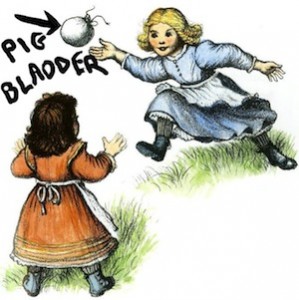
They are at subsistence level, and Pa is a trapper by trade not a “handyman” like he is in the TV show. Pa’s job is to trap, hunt and fish, and the landscape is lousy with animals and the disambiguation thereof, Deer, bear, muskrat, mink, foxes, wolves and other cadavers bloodily splayed. The Ingalls prepared for winter by smoking venison inside an upright log and butchering the pig. Laura has to run and hide and stop her ears so as not to here the squealing of the hog Pa is slaughtering, they chew on the roasted pig’s tail and they play catch with a balloon made of the pig’s bladder.
Then there is the issue of Pa.
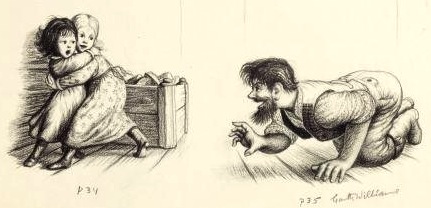
When I was a kid, Ma and Pa were second (Mr and Mrs Brady were #1, I know, I know), in the pantheon of “Fictional Parents” I wanted instead of my own. I thought Pa was fun because he played the fiddle and played with the girls. Now I realize that Pa should have been institutionalized. He belongs in a 19th century padded cel. He was constantly putting his family in unnecessary perilous situations. When I first read these books, I was thrilled by the peril – God’s wrath in the way of blizzards or infestations could strike at any moment, but I always felt secure in the knowledge that Laura would be safe thanks to the reassuring presence of Ma and Pa.

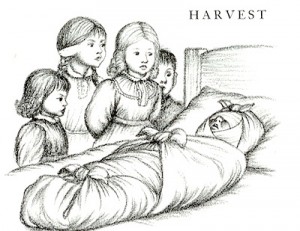
Even though Pa is certifiable, and wolves and bears and black panthers prowl an howl outside at hight, I would have traded places with Laura. Because she is safe and cozy in her trundle bed. They’ve got all the coziness you can handle, but with a steely edge of self-sufficiency. I’m convinced that if there’s an end-of-the-world situation, my incessant childhood readings of the Little House books have given me all the knowledge I need to survive; make a house, a door, smoke a pig, etc.
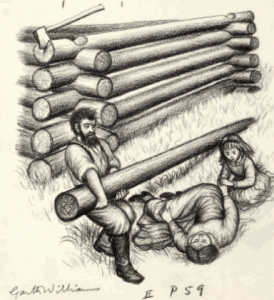
NOT COZY
 Little Women
Little Women
The March girls live in poverty, but it is a “genteel poverty”. They look so good being poor! They have so much fun being poor! M. They sing together, sew together, rally round hardship together. Her husband loses all her money, then heads off to join an army that does not particularly want him, leaving her alone to raise four daughters, e.g. and Jo had to find jobs and support the family! Good times from becoming the even poorer Hummels down the street, might coThey have old raggedy dresses and gloves. When Jo tries to curl Meg’s hair, she burns her bangs off!!
Bratty Amy is a “regular snow-maiden” with curly golden hair and blue eyes, pale and slender and “always carrying herself like a very proper young lady.’ She is “Petted” and spoiled. I couldn’t believe a poor girl could act like a brat! Nellie was rich so it made sense. Amy was a brat AND everyone loved her anyway. So what’s so bad about being poor?
Sure, she gets a beating – a beating! When Amy burns Jo’s manuscript in an extraordinary act of pique, she doest even get in trouble because no sooner has she decided to never speak to her sister again than pretty Amy goes plunging through thin ice into a freezing river. Even Amy’s great vanity is not discouraged, but encouraged; she is given not only true love – the desirable Laurie – but made mistress of a house where she can tinker with painting and become a great benefactress of the arts. It all works out!!!
This is kind of embarrassing. My sister and I “played” “being poor”. One of us would play the wicked parent/orphanage mistress/stepparent and “beat” the other. 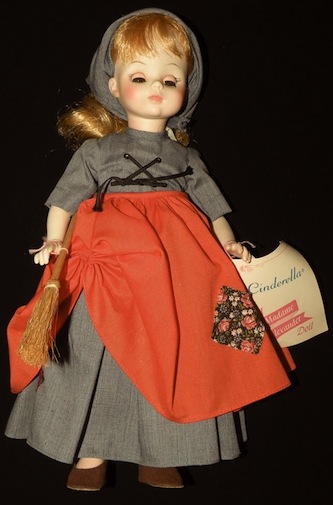 There was a heavy emphasis on “beatings”. We had a “poor” Cinderella doll that we loved because she wore rags. We would remove the fine dresses from our fancy dolls and leave on their cotton slips and put scarves not heir heads and pretend they were poor. My best friends Karen and Stefanie and I would pretend we were starving orphans, dressing in rags and wailing. We’d take my Easter basket and pretend that all we had in the world was in that basket — we was so poor. We embraced the other arc, too, the lonely-misery-to-happy-family pattern, like Sarah Crewe. Of course we knew that people don’t generally want to be poor. “You don’t get no bread with just one meatball” is a Depression era song my dad used to sing, and have to explain. He really WAS an orphan, and would commonly make comic references to such: “what am I, an orphan?”. The fact that he spent his first years in an orphanage in NY didn’t concern me – that reality didn’t interest me then AT ALL. I was interested in the Sara Crew kind of orphan, the lovable moppets in the 1970s version of Oliver! kind of orphans. Later I’d learn that having no money makes you pretty fucking unhappy — constantly thinking about how you don’t have money or a way to get money and how there’s no way, mathematically, you can pay your rent and Con Ed bill. All you can think about is money and food and how you don’t have either. No one fantasizes about being poor anymore, do they? Not even in that doe-eyed, naïve way some kids fantasized about being orphans or hobo train-hoppers in the 70’s?
There was a heavy emphasis on “beatings”. We had a “poor” Cinderella doll that we loved because she wore rags. We would remove the fine dresses from our fancy dolls and leave on their cotton slips and put scarves not heir heads and pretend they were poor. My best friends Karen and Stefanie and I would pretend we were starving orphans, dressing in rags and wailing. We’d take my Easter basket and pretend that all we had in the world was in that basket — we was so poor. We embraced the other arc, too, the lonely-misery-to-happy-family pattern, like Sarah Crewe. Of course we knew that people don’t generally want to be poor. “You don’t get no bread with just one meatball” is a Depression era song my dad used to sing, and have to explain. He really WAS an orphan, and would commonly make comic references to such: “what am I, an orphan?”. The fact that he spent his first years in an orphanage in NY didn’t concern me – that reality didn’t interest me then AT ALL. I was interested in the Sara Crew kind of orphan, the lovable moppets in the 1970s version of Oliver! kind of orphans. Later I’d learn that having no money makes you pretty fucking unhappy — constantly thinking about how you don’t have money or a way to get money and how there’s no way, mathematically, you can pay your rent and Con Ed bill. All you can think about is money and food and how you don’t have either. No one fantasizes about being poor anymore, do they? Not even in that doe-eyed, naïve way some kids fantasized about being orphans or hobo train-hoppers in the 70’s?

